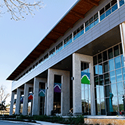Organizational Charges to the Chancellor 2024-2025
 |
|
Active Goals
Prepare the Alamo Colleges District organization and stakeholders to meet the demands of the future with a focus on how the organization can proactively plan for and support changes in education, training, employment, and the economy.
- Strategic Planning: Execute a strategic planning process that captures stakeholder feedback and positions the Alamo Colleges District on a multi-year path while building on an award-winning foundation.
- 2025 Bond: Design a 2025 Bond based on current and projected enrollment growth, future population demographics, and industry dynamics to address talent gaps including High Wage/High Value sectors (i.e., aviation, bioscience, health care, IT, manufacturing).
- Comprehensive Campaign: Develop the outline of a Comprehensive Campaign with the assistance of a partner firm to determine the scope of the campaign and begin to identify resource priorities and partners.
- Develop an optimal organizational structure to support continued student enrollment growth and ensure a high-quality student experience. Faced with two colleges approaching 20,000 students each, determine the optimal college size (on-campus & online) to be positioned for the future as well as ensure access throughout Bexar County, the service area, and the State of Texas.
Support student success at Alamo Colleges District through a demonstrated awareness and willingness to address challenges and close performance gaps, including:
- Explore opportunities to innovate and enhance the student advising model through the integration of digital tools and personalized student pathways. Investigate and evaluate the potential of predictive analytics and AI-driven insights to provide tailored advising experiences that deliver timely guidance and support to students in achieving their educational goals. Identify and assess tools and technologies that are compatible with our existing architecture, ensuring a seamless implementation that aligns with the district's strategic objectives.
- Support equitable educational outcomes for all students, with a focus on academically and economically disadvantaged, underserved students, parenting students, first-generation college students, and students twenty-five years of age and older.
- Implement and utilize the Caring Campus framework to create a college environment that increases students’ sense of connectedness, belonging, and completion of their educational goals.
- Align the systemwide Key Performance Indicator portfolio to ensure student success outcomes are achieved and requisite resources are reinvested in the organization for technology and infrastructure improvements.
- Continue to enhance the Student Advocacy Network service portfolio to provide critical wrap-around support services for student retention and completion.
- Expand support services for parenting students, including expansion of childcare centers and drop-in services.
- Work to achieve the Texas Higher Education Coordinating Board
(THECB) and State of Texas’s strategic goals as outlined in the “Building a Talent Strong Texas” plan by increasing our yearly goal of 10,500 to 12,000 degrees and certificates achieved. - Develop and present a final proposal for the workforce-oriented bachelor’s degree program at Northeast Lakeview College to complement the AlamoU portfolio of four previously approved bachelor’s degree programs. Begin developing a framework of evaluative data from graduates to inform continuous improvement of the bachelor’s degree programs.
- Continue to increase course transfer alignment and transfer rates through the Regional University Transfer Compact and new partnerships with universities across Texas.
- Implement a hard-wired transfer partnership program utilizing AlamoINSTITUTES and the Transfer Advising Guides/Workforce Development Plans to ensure students from ACD transfer to four-year universities with at least 15 semester credit hours.
- Expand and create new and innovative workforce programs to meet the increased demand for talent in high-wage and high-demand occupations and industries.
- Expand Ready to Work and continue to support the city/county’s goals on student completion and job placement. Examine how the Alamo Colleges District will support individuals as Ready to Work funding expires.
- Collaborate with the city and county, GreaterSATX/SA WORX, and chambers of commerce to enhance the region's workforce development efforts.
- Implement the Schools and Centers model (AlamoINSTITUTES 2.0) to create robust pathways for students to seamlessly complete a beginning certification/degree program at one college and ultimately continue to a bachelor’s degree program at a School or Center’s host college.
- Pursue systemwide involvement in the Aspen Institute’s Unlocking Opportunity Initiative, which seeks to increase the number of students, including first-generation and under-resourced students, entering and completing programs that lead directly to jobs that pay a family-sustaining wage or to efficient and effective completion of a bachelor’s degree.
- Explore the expansion of digital student support services, including virtual advising, mental health resources, and academic coaching. Assess and evaluate emerging technologies that can create a seamless and integrated student experience, particularly for online learners, with a focus on supporting engagement, retention, and completion. Investigate tools and platforms that align with our existing infrastructure to ensure effective and scalable implementation.
- Create a long-term organizational strategy for online learning, enhancing enrollment, retention, marketing, program design, and completion in support of five-year online student enrollment projections.
- Advance human and technological infrastructure to support current capabilities such as recruitment, curriculum design, assessment, and career planning, while incorporating emerging capabilities for successful digital learning. Measure digital capabilities across the learner lifecycle, ultimately to support practical and sustainable approaches to digital services and online learning.
- Align micro-credential strategy, adoption, implementation, and investment to THECB’s Building a Talent Strong Texas plan and House Bill 8 completion targets.
- Continue implementation of the overarching Alamo Colleges District-Wide Strategic Enrollment Management Plan to facilitate smart growth and increase market penetration into the community.
- Ensure a continued level of access through AlamoPROMISE with the recent Bexar County-wide expansion to seventy-three public high schools as well as charter, private, and home-schooled students. Continue to pursue collective impact strategies for increased funding.
- Identify areas of student/institutional challenges and set goals for improvement of student outcomes, including metrics that measure connection and completion success for Alamo College District learners.
- Scale high school equivalency offerings with a diploma option and dual credit opportunities across the Alamo Colleges District.
- Expand preparatory support for prospective ACD students pursuing the Texas Success Initiative Assessment (TSIA) college readiness exam.
- Develop a sustainable program for recruitment and retention of high-quality talent. Utilize the framework and findings from Great Places to Work to inform the process.
- Develop a Career Readiness program with professional development opportunities to cross-train employees in pursuit of career growth.
- Continue to monitor ongoing competitive compensation program for faculty, staff, and administrators.
- Increase educational attainment rates and improve economic and social mobility through a comprehensive portfolio of high school programs, including Dual Credit, Early College High School, P-Tech, Alamo Academies, and other program models.
- Develop a proposal to ensure 50% of dual credit students complete a sequence of at least 15 semester credit hours in dual credit courses by high school graduation.
- Successfully implement the downward expansion of the AlamoADVISE model to serve dually enrolled high school students.
Monitored Goals
Expand implementation and refinement of continuous improvement activities, including but not limited to the three elements of the AlamoWAY:
- Student Success
- Principle-Centered Leadership
- Performance Excellence
Strengthen the Alamo Colleges District brand while promoting awareness of new and emerging Alamo Colleges District initiatives using targeted marketing and communications strategies such as:
- Increase synergy and collaboration in communications and marketing across the Alamo Colleges District by formalizing communications and marking committees, councils, and gatherings of subject matter experts across the Alamo Colleges District family.
- Enhance ties with prospective students and parents to encourage enrollment through community and neighborhood-based activations via Community Connections and other community outreach programs.
- Monitor and report on AlamoEXPERIENCE, which will provide each graduating student with a workplace-based learning opportunity (i.e., apprenticeship, internship, community service/service learning, on-campus employment).
- Develop and implement the Earn & Learn component of AlamoEXPERIENCE, allowing students to build professional social capital through apprenticeships, community service/service learning, internships, and employment opportunities.
More information:
| Office of the Chancellor | Board of Trustees |






